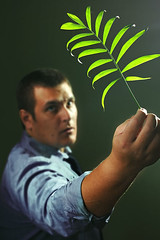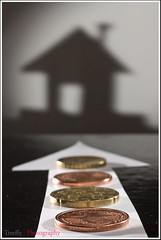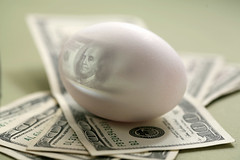 Report from Assignment 5.2 -- Double-Duty Light, in which you were asked to illustrate one of three concepts: Physical fitness, financial planning or going green. You were asked to stretch your lighting budget by reflecting and/or refracting one light source.
Report from Assignment 5.2 -- Double-Duty Light, in which you were asked to illustrate one of three concepts: Physical fitness, financial planning or going green. You were asked to stretch your lighting budget by reflecting and/or refracting one light source.Lots of really cool stuff this time. We'll be looking at four examples, pointing to a few more and linking in to some photogs who went the extra mile and chose to blog or video their efforts -- after the jump.
__________
Long story short, you guys turned out to be luminary contortionists. I hope you enjoyed finding out what one light could accoplish as much as I enjoyed watching you.
This is one of those times where there was an embarrassment of riches, as far as the number of good photos was concerned. So as visual examples, I am looking at three people who took different directions with their light. (No pun intended).
 Leading off is Lbeetge and his "going green" theme.
Leading off is Lbeetge and his "going green" theme. He chose to start with strong, undiffused backlight, which he sent through his plant to make it glow. This hot light coming from back camera right (via a Sunpak 4205 flash) was easy to reflect back into front camera left using two silver reflector boards.
I love the way the plant goes a little nuclear. (Or, "nukuler," as our Commander-in-Chief says.)
Starting with a hard light from the back is a useful way to stretch your lumens budget, and it translates well to working with hard, directional sunlight, too. But since you can create hard, directional light any time you want with your speedlight, this is something you can do any time, anywhere.
 Batting second is Nick.Flick, who managed to conjure up a whole studio for this one-source, wrapped-light photo.
Batting second is Nick.Flick, who managed to conjure up a whole studio for this one-source, wrapped-light photo.The flash is coming in bare from back camera left. It is reflected by a mirror on camera right. (Thus, the "wrap.") A fill card is at camera front light to paint a nice soft light on the cans in front.
Still not exactly sure what he shot the flash through for the background light. (Even after looking at the setup shot...)
 Third up, we have treeffe2000, who did pretty much everything except for project some birds and clouds into the sky on his background.
Third up, we have treeffe2000, who did pretty much everything except for project some birds and clouds into the sky on his background.Flash comes in bare from back camera left, lighting the coins. It is then reflected from camera right, to light the coins from the other direction. (A piece of paper was also used above the coins to catch some raw light and paint a nice smooth tone.)
A mirror at camera left also catches some raw light and sends it through a house-shaped gobo to create the background image.
The setup shot is here. Bonus points for the Elliott Erwitt book on dogs. I love that one, too.
 And batting clean-up (and a grand slam, IMO) is this shot which I marked earlier -- then missed it because it for some reason does not show up in the tag search.
And batting clean-up (and a grand slam, IMO) is this shot which I marked earlier -- then missed it because it for some reason does not show up in the tag search.It is by The Light Whisperer, which is an appropriate name as far as I am concerned.
One light.
I am proud to say that I was able to reverse engineer it - but only by narrowing it down to two guesses. Try to figure it out before clicking through to the photo to see it bigger and read how it was done. This is an slick idea, and I never would have thought if it. Triple aces.
_____________
Neat stuff, all. And if you want to see more, check out:
• Paul Morton's penny -- setup shot here
• Jon's dime -- link is to a how-to post
• Meyerson posted on his quarter shot, here
• D. W. Heywood's racquetball player
• Steve's aging muscles
• Nick's nest egg -- with a how-to video
• And (other) Nick's bucket-o-coin, which took the cake for most complex -- setup here
(You can see everyone's tagged stuff here.)
_______________
Which did you like best? Why? And, while we are asking questions, where's mine?
Dog ate my homework.
(Just kidding. It's coming next. But I won't be topping that $100 egg...)
Next: My shot.




0 comments:
Post a Comment